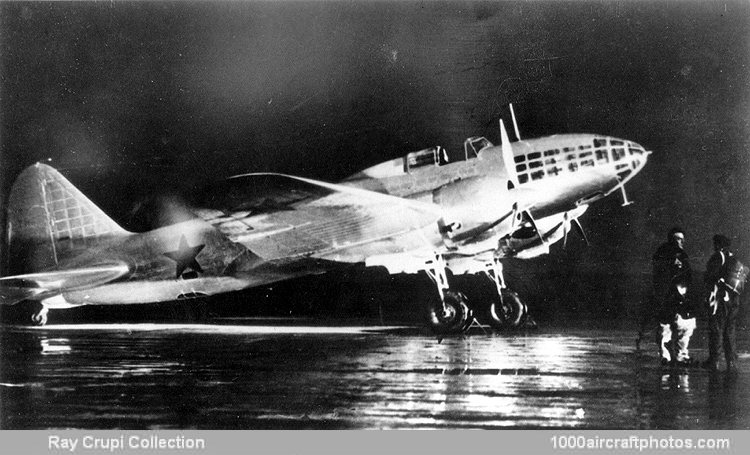09/30/2016. Remarks by Johan Visschedijk: "In 1938, the nose of the DB-3B was completely redesigned - the cumbersome nose turret being replaced by a slim, glazed pointed nose with a swivel gun-mounting. The back of the pilot's seat was provided with 0.35 in (9 mm) armor protection. Altitude performance was improved by replacing the M-86 with the M-87 A which had the same take off power but developed 900 hp at 15,420 ft (4,700 m), and by fitting the new VISh-23 three-blade variable-pitch metal propeller with a diameter of 11 ft 2 in (3.4 m). Oil-cooler intakes were extended forward to the leading edge of the cowling. Armament and bomb load of the latest version which was designated DB-3F (forsirovannie - boosted) was the same as on the DB-3B, except that the rear gunner's ventral weapon was now on a hinged mounting. The DB-3F completed its State trials in June, 1939.
In 1942, the M-87A was replaced by the 1,100 hp M-88B with a two-speed supercharger; with this engine take off power was maintained up to 13,120 ft (4,000 m); and at 19,685 ft (6,000 m) the M-88B developed 1,000 hp. At about the same time the rear gunner's ShKAS machine gun was replaced by a single 0.50 in (12.7 mm) DBT heavy caliber machine gun, and the new-style designation Il-4 allocated. During the period in 1942 when wooden wing spars replaced the metal spars while light alloys were in short supply, there was a small increase in gross weight and a 2.5 mph (4 kmh) reduction in speed. The Il-4's navigational equipment included a radio compass and APG-1 autopilot
During the WW II the Il-4 was used in a variety of roles. Not only was it the only Soviet long-range bomber (excluding a handful of Pe-8s) but it was also used tactically, for photographic reconnaissance, glider towing, and even carried seven men and their equipment as a troop transport and was also used by the Navy as a torpedo-bomber (see 3-view) when a 17.72 in (450 mm) 2,072 lb (940 kg) 45-36-AN (low level) or 45-36-AV (high-level) torpedo was carried beneath the fuselage, with a small compressed-air tank behind for running up the torpedo before release.
Between 1937 and 1940, 1,528 DB-3s were produced; modern production methods were introduced in 1940 and between then and 1944 when production ceased, 5,256 DB-3Fs and Il-4s were built. The DB-3F was the first Soviet aircraft to bomb Berlin during the war when a formation of long-range bombers, of the 1st Guards Mine/Torpedo-bomber Aviation Regiment of the VVS Baltic Fleet, under the command of Colonel E. N. Preobrazhenskii, attacked the German capital during the night of August 8, 1941.
Both the DB-3B and DB-3F were used on the Finnish Front, and in 1944, the Finnish PLeLv 46 bomber squadron operated three of each alongside its Dornier bombers."
